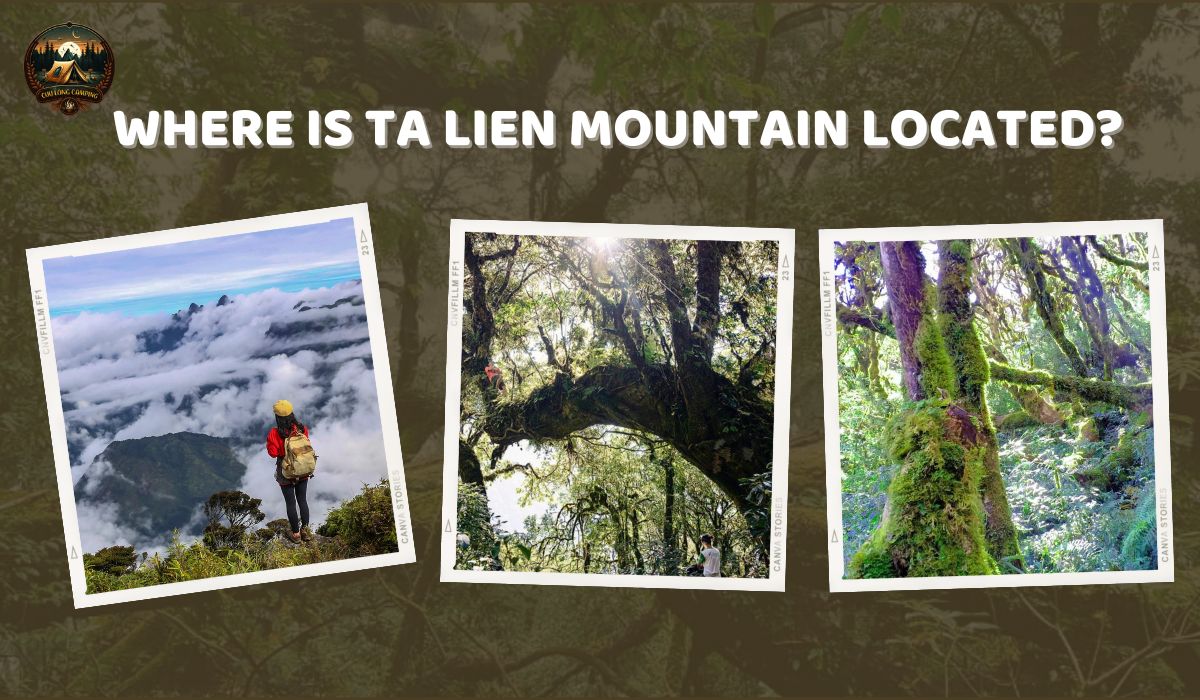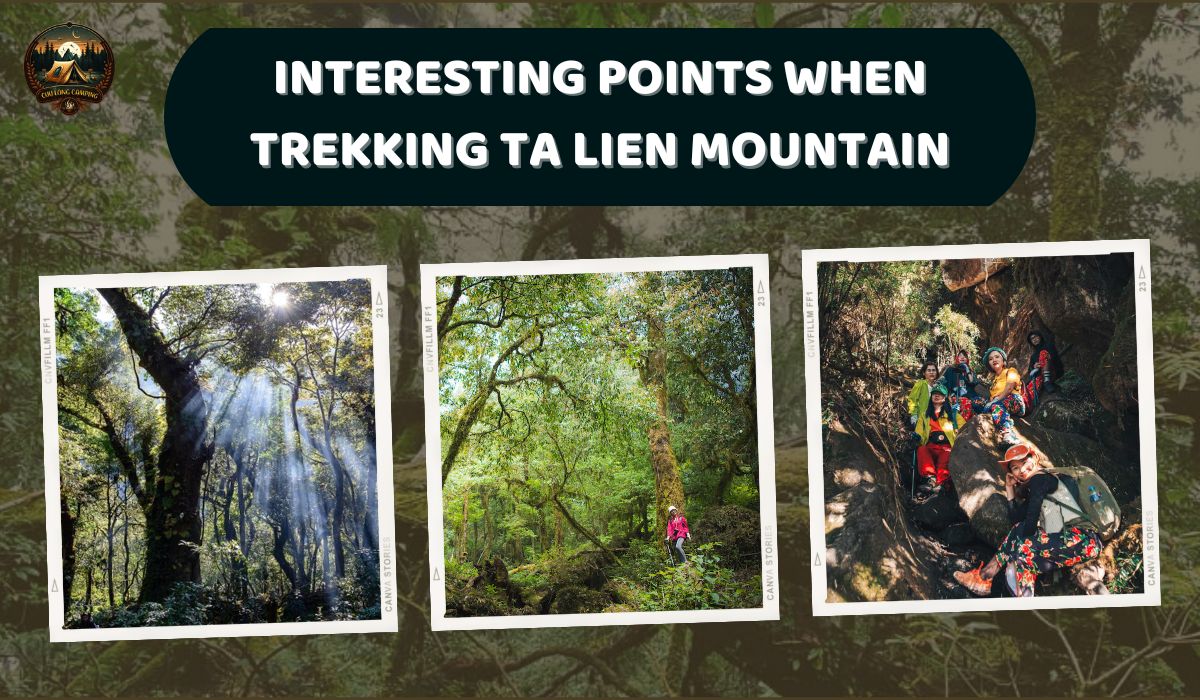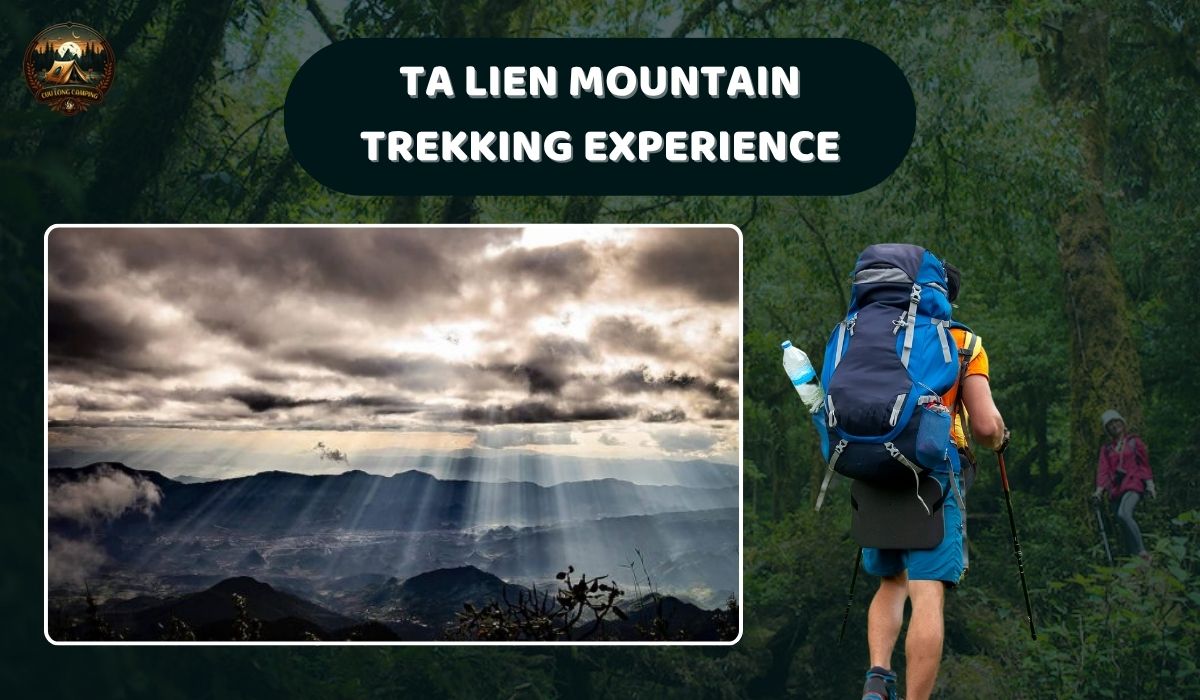Ta Lien Son, a majestic mountain belonging to the Hoang Lien Son range, located in Ta Leng commune, Tam Duong district, Lai Chau province, has long been an attractive destination for those who love trekking and exploring nature. With an altitude of 2,996m above sea level, Ta Lien is dubbed the “6th highest peak” of Vietnam, harboring the pristine, magnificent beauty of a “fairy forest” amidst the vast Northwest mountains. This article by Cuu Long Camping will provide you with useful information to prepare for your exciting Trekking Ta Lien Mountain journey.
Where is Ta Lien Mountain Located?

Ta Lien Mountain, also known as Co Trau, is located in Ta Leng commune, Tam Duong district, Lai Chau province. This mountain is situated in the majestic Hoang Lien Son range and is part of the border region between Lai Chau and Lao Cai provinces.
To be more specific:
- Administrative location: Ta Leng Commune, Tam Duong District, Lai Chau Province.
- Geographical location: Located within the Hoang Lien Son range, near the border with Lao Cai.
- Distance: Approximately 10km from Lai Chau City.
Ta Lien Mountain has an altitude of 2,996 meters above sea level, ranking as the 6th highest mountain in Vietnam. Therefore, it attracts many people who love mountain climbing and exploring nature.
Some notable points about Ta Lien Mountain’s location:
- Terrain: The terrain is mainly primeval forest with rich vegetation.
- Climate: High mountain climate, with distinct seasonal variations. Winter can be very cold, with hoarfrost and ice/snow.
- Scenery: The Ta Lien mountain region is famous for its majestic natural scenery, especially the red maple forests in autumn.
Interesting Points When Trekking Ta Lien Mountain

Trekking Ta Lien Mountain offers many exciting experiences, not just conquering the peak but also a journey to discover nature and unique culture. Here are some interesting points you can experience when trekking Ta Lien:
1. Discovering a Diverse Ecosystem:
- Primeval forest: Ta Lien is covered by dense primeval forests with rich vegetation. You will admire ancient trees hundreds of years old, covered with moss and ferns, creating a magnificent and mysterious landscape.
- Vegetation changing with altitude: The higher you go, the more the vegetation changes, from humid tropical rainforests at the foot of the mountain to temperate forests with coniferous trees at higher altitudes.
- Biodiversity: Ta Lien is home to many rare animal and plant species; if lucky, you might spot some wild animals.
2. Admiring Stunning Natural Scenery:
- Red maple forest (in autumn): This is one of the most special features of Ta Lien. In autumn (September – November), the maple forests turn vibrant yellow, orange, and red, creating an incredibly romantic and impressive scene, like a beautiful painting.
- Rhododendron flowers (in spring): In spring (March – May), rhododendron flowers bloom brightly on the mountainsides, adorning Ta Lien with fresh colors.
- Sea of clouds: Standing on the peak of Ta Lien, you will admire the floating sea of clouds covering the surrounding mountains, a majestic and splendid sight.
- Deep valleys: Looking down from above, you will see deep valleys with winding streams, creating a pristine and magnificent natural picture.
3. Experiencing Local Culture:
- Meeting ethnic people: Along the trekking route, you may meet ethnic minorities living in the area, learning about their culture, customs, and daily life.
- Enjoying local cuisine: You can savor special dishes of the Northwest mountains such as smoked buffalo meat, upland sticky rice, grilled chicken, etc.
4. Challenging Yourself and Improving Health:
- Conquering altitude: With an altitude of 2,996m, Ta Lien is a significant challenge for trekking enthusiasts. Conquering the peak will bring you a sense of pride and satisfaction.
- Improving health: Trekking Ta Lien requires good health and endurance, which is a great opportunity to improve your health and enhance your flexibility.
5. Feeling at One with Nature:
- Quiet and peaceful: Separated from the bustling city life, you will enjoy the quiet and peaceful space of the mountains and forests.
- Connecting with nature: Trekking Ta Lien helps you connect deeply with nature, feeling the pristine and majestic beauty of the Northwest mountains.
Ta Lien Mountain Trekking Experience

Trekking Ta Lien Mountain is a wonderful but also challenging experience. To have a safe and memorable trip, thorough preparation is crucial. Here are some Ta Lien Mountain trekking experiences compiled from various sources, giving you an overview and helping you prepare best for your journey:
1. Ideal Time for Trekking Ta Lien Mountain:
- From September to May of the following year: This is the dry season, with little rain, favorable for moving and climbing.
- September – November (Autumn): Trekking Ta Lien Mountain is most beautiful during this season with maple trees turning vibrant yellow and red. However, the weather can be chilly at night and early morning.
- December – February (Winter): Temperatures drop low, and there may be ice and snow on the mountaintop. Suitable for those who like to experience the cold of the highlands. You need to prepare warm clothing carefully.
- March – May (Spring): Warmer weather, rhododendron flowers blooming, beautiful scenery.
2. Prepare Health and Physical Fitness:
- Regular exercise: At least 1-2 months before the trip, you should practice cardio exercises (running, cycling, swimming) and leg strength training exercises to have the best physical fitness.
- Health check-up: If you have a history of cardiovascular disease, blood pressure issues, or other chronic illnesses, you should consult a doctor before going.
3. Prepare Equipment:
- Trekking shoes: Choose specialized shoes with good grip, waterproof, snug-fitting, and already broken-in to avoid blisters.
- Backpack: Specialized mountaineering backpack, appropriate size (40-60 liters), with hip and shoulder support straps.
- Clothing:
- Comfortable, sweat-wicking clothing.
- Warm jacket, thermal wear, waterproof windbreaker.
- Gloves, wool hat, warm socks.
- Personal items:
- Sunscreen, sunglasses, hat.
- Personal medication (headache, stomachache, allergies, etc.).
- Flashlight, lighter, multi-tool knife.
- Personal water bottle, hydration bladder.
- Snacks (energy bars, dried food, chocolate, etc.).
- Sleeping bag (if sleeping in a hut or self-sufficient).
- Personal first-aid kit.
- Trekking poles: Helps reduce pressure on knees and maintain better balance.
4. Itinerary and Tour Selection:
- Popular itineraries: Usually 2 days 1 night or 3 days 2 nights.
- Self-sufficient or guided tour:
- Self-sufficient: Suitable for experienced trekkers who understand the terrain and can handle situations independently. Requires thorough preparation in all aspects.
- Guided tour: A safer and more convenient option for beginners. Tours often include porters, guides, meals, tents, and essential items. You should choose reputable tour companies.
5. Hiring Porters and Guides:
- Porter: A person who carries your belongings, easing the burden of your trip.
- Guide: An experienced person who understands the terrain, weather, and local culture, helping you move safely and providing useful information. You should hire local people to get the best support and contribute to local economic development.
6. Important Notes:
- Absolutely do not trek alone: Always go in a group and follow the instructions of the porter and guide.
- Maintain environmental hygiene: Do not litter indiscriminately, protect nature.
- Do not wander off from the group: Especially when crossing streams, climbing slopes, or walking in dense forests.
- Prepare enough drinking water: Drink enough water to avoid dehydration during physical activity.
- Inform relatives about the itinerary: For safety, let your family know about your itinerary and estimated trip completion time.
- Learn about the weather: Monitor the weather forecast before and during the trip to prepare appropriately.
- Coping with bad weather: If you encounter bad weather (heavy rain, dense fog), find a safe shelter and wait for better weather before continuing.
- Respect local culture: Learn about and respect the customs and traditions of the local people.
7. Other Tips:
- Divide your belongings and distribute them evenly in your backpack: This helps balance your backpack and makes it easier to move.
- Use waterproof bags for electronics and important items.
- Bring some cash: In case there’s no phone signal for transfers.
- Be mentally relaxed and ready to face challenges.
We are a group of young people in the Mekong Delta who are passionate about travel, with the dream of discovering many beautiful places to develop sustainable and environmentally friendly tourism. Follow Cuu Long Camping to explore all the beautiful scenery of the Mekong Delta and many new lands on our trips here!





